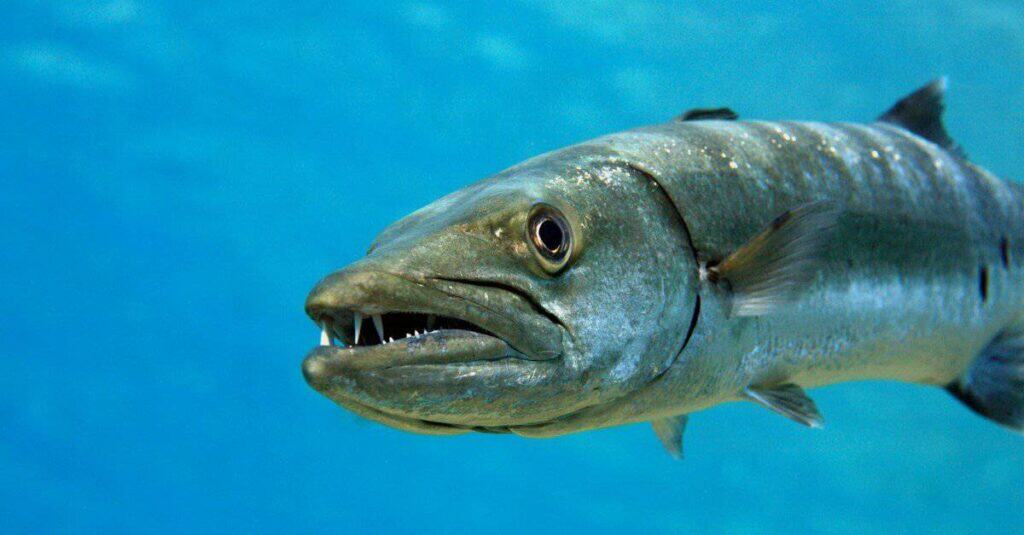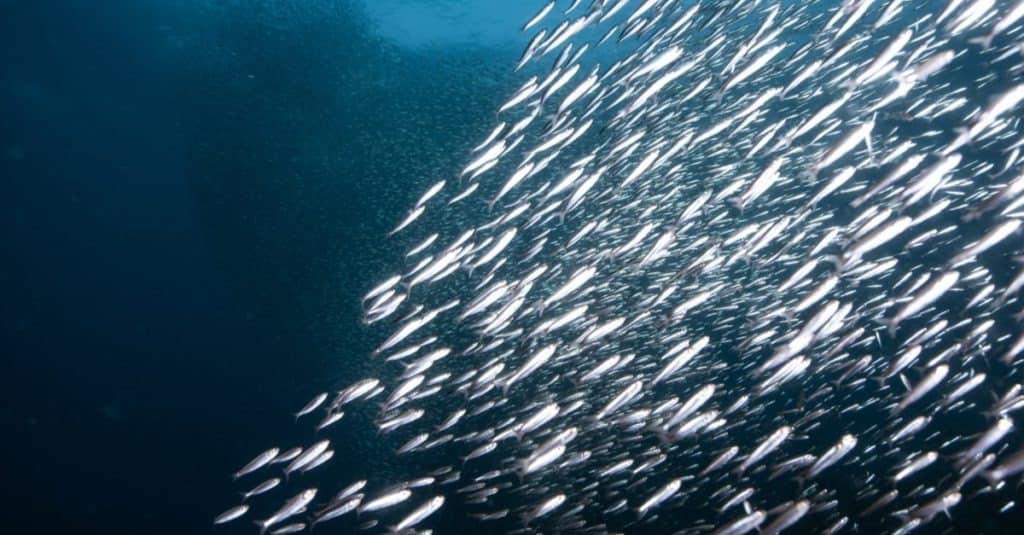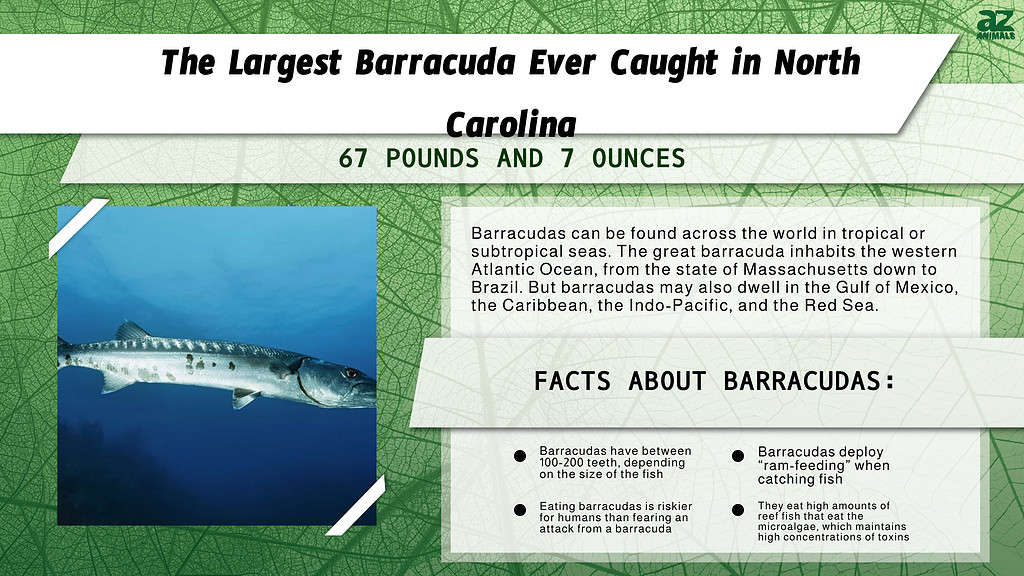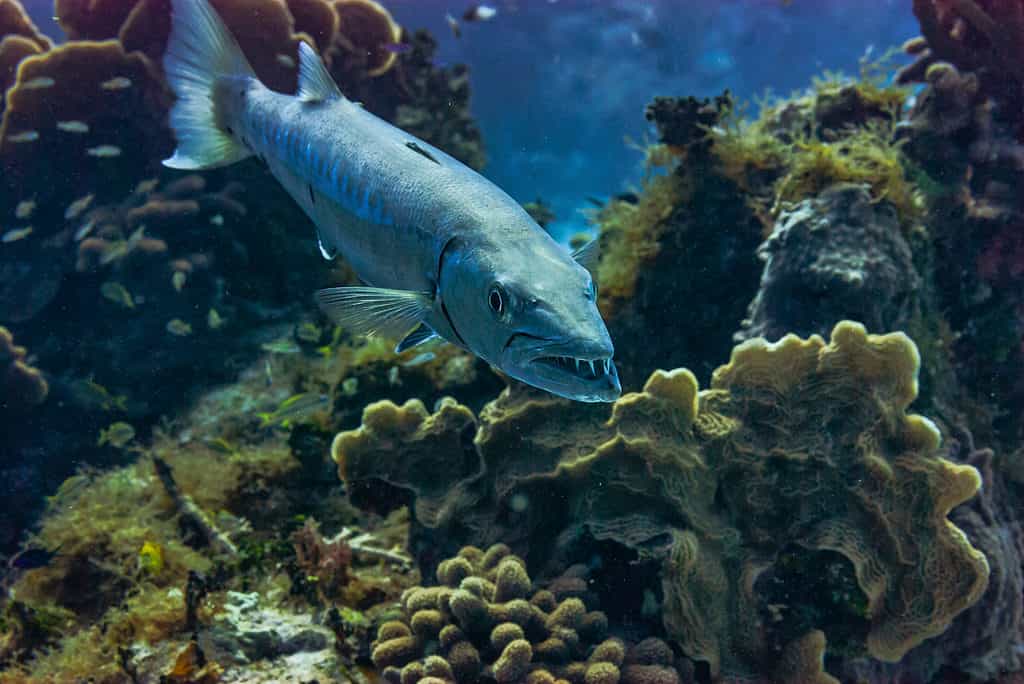Barracudas are efficient predators with very few enemies. Because of their speed, size, and spectacular teeth, not many creatures would like to face off with a barracuda. However, fishermen love barracuda as game fish and food, and many find fishing for a barracuda to be an adrenaline rush. There are many places in the United States where you can go toe-to-toe with a barracuda, including North Carolina. But you won’t believe the size of the largest barracuda caught in North Carolina.
About Barracudas

Barracudas are adept hunters with few predators because of their speed and size.
©aquapix/Shutterstock.com
Most barracudas along the Atlantic coast grow to be 18 inches in length, but the largest species, the great barracuda, has been known to reach 10 feet long. Barracudas weigh between 5.5 to 20 pounds on average, but that is nothing compared to the largest barracuda caught in North Carolina. Usually, the females are larger than the males. And, because an adult barracuda has barely any predators, they can live up to 14 years.
A barracuda’s upper body is dark gray, dark green, white, or blue. Its underbelly is dusty white, highlighted by silvery sides. Their bodies are covered in tiny scales with two dorsal fins that are widely separated. The fins may have a yellowish or dark coloring.
These fish are very muscular and shaped like a torpedo. In a barracuda’s mouth are two rows of razor-sharp teeth. The lower jaw extends out further than the upper jaw, giving the barracuda a scissor-like bite. This shape allows the barracuda to shear through the flesh and bone of its prey, slicing it down into digestible bites.
Barracuda’s Teeth

Barracudas are polyphyodonts, which means they continually replace their teeth if lost.
©iStock.com/Ashley-Belle Burns
Barracudas have between 100-200 teeth, depending on the size of the fish. Some of the teeth point backward to prevent slippery fish from escaping the barracuda’s grip. Lining the outside of the jaw is a row of small, sharp teeth. This row is closely packed and helps with slicing the prey apart. The barracuda’s inner row features much taller and pointier teeth, averaging 1-1.5 inches long. These teeth puncture and prevent prey from wriggling out of the mouth, and the inner teeth also help shred the meat down to swallowable pieces.
What is unusual for a barracuda is that it has empty sockets in its jaw that the teeth fit into. This way, a barracuda can seal its mouth, hiding its teeth until it is ready to strike. This fish is also a polyphyodont, which means its teeth are continually replaced when they lose them. Contrast that to diphyodonts, like us, who only get two sets of teeth during our life: our baby teeth and our adult teeth.
Barracuda’s Diet

Anchovies are one of the species of fish that barracuda eat.
©Divefriday/Shutterstock.com
While barracudas love their meat, they are specifically piscivorous, mainly eating fish. While eating smaller fish species is simple for the barracuda, they have been known to go after fish bigger than themselves.
Barracudas deploy “ram-feeding” when catching fish. That is when a barracuda rams into prey at high speeds, stunning the prey before grabbing the target in its powerful, shredding bite. Using its scissor-like jaw and rapid head shakes, it tears the prey into pieces that are easy to swallow.
The type of fish barracudas generally eats include snappers, small tunas, mullets, herrings, anchovies, groupers, and sardines. The only predators that the barracuda needs to watch out for are sharks, killer whales, dolphins, Goliath groupers, and humans. Sports fishermen love showing off a sizeable barracuda.
Where Barracudas Live
Barracudas can be found across the world in tropical or subtropical seas. The great barracuda inhabits the western Atlantic Ocean, from the state of Massachusetts down to Brazil. But barracudas may also dwell in the Gulf of Mexico, the Caribbean, the Indo-Pacific, and the Red Sea.
These fish like to occupy shorelines with coral reefs, seagrass beds, mangrove forests, or any place abundant with fish. They tend to spend their time in shallower waters but have been known to live in depths of up to 330 feet.

Are Barracudas Dangerous?

Great barracudas can reach over 100 pounds.
©Focused Adventures/Shutterstock.com
Incidents of barracudas attacking humans are very rare, and they usually don’t bite out of aggression. Barracudas track prey more by sight than smell and can detect even small changes visually in the water. So, if there’s a shiny watch on a snorkeler or a flashing piece of metal on a diver, a barracuda may mistake it as a glint of a fish.
In reports of a barracuda attack, there is usually only one quick bite, resulting in a puncture wound or tissue loss. In fact, the last fatal barracuda attack in North Carolina occurred in 1957. It’s been 66 years since that took place. Barracuda attacks are rare given all the activity on the North Carolinian coast and the decades of people swimming in the water since 1957!
Surprisingly, eating barracudas is riskier for humans than fearing an attack from a barracuda. Ciguatera fish poisoning is from consuming fish that have high levels of toxins made by marine microalgae. Barracudas, because they eat high amounts of reef fish that eat the microalgae, maintain high concentrations of the toxin.
Symptoms of ciguatera fish poisoning may include vomiting, nausea, and neurological effects such as tingling of the fingers and toes. Another bizarre sign is that cold objects feel hot to the touch, and hot surfaces feel cold.
Unfortunately, there is no way to cure ciguatera, but the body usually heals in a few days or weeks. In some cases, it may take years to clear up. In the meantime, your primary doctor can help treat your symptoms to make you more comfortable.
Barracudas aren’t the only fish species that put you at risk of ciguatera. The moray eel, grouper, sea bass, tuna, mackerel, and hogfish are also offenders. Medical professionals say that ciguatera is the most prevalent seafood toxin illness.
The Largest Barracuda Ever Caught in North Carolina

The fisherman Buddy D. Garten was the one who caught the largest barracuda in North Carolina in 1985.
©BlueOrange Studio/Shutterstock.com
The fisherman Buddy D. Garten was the one who caught the largest barracuda in North Carolina in 1985. He caught it at the Cape Lookout; the specimen was 67 pounds and 7 ounces! Talk about a catch!
A full-grown male pit bull averages 50 pounds in weight. Can you imagine a fish that big in your trophy room?
The Largest Barracuda Caught Worldwide
But, the largest barracuda ever caught in North Carolina pales compared to the biggest one caught worldwide. In 2013, Thomas Gibson, Jr. left his home in Texas for a fishing trip on the Cuanza River in Angola. His main objective was tarpon, and he successfully caught 28 tarpons during his week’s adventure. However, after a 10-minute struggle reeling a fish in, Gibson Jr. won his prize. It was not a tarpon, however, but a giant barracuda!
This beast was 102 pounds and 8 ounces in weight and 6 feet, 10 inches long. The International Game Fish Association recorded it as the largest barracuda ever caught.
Wrapping Up the Largest Barracuda Caught in North Carolina
The largest barracuda ever caught in North Carolina is an impressive record. The barracuda’s small list of predators enables these fish to grow as big as these records show. But barracudas are also crucial to the ocean food chain because they eat sick and vulnerable fish from healthy populations. And because barracudas are regarded as sport fish and risky to eat, the barracuda population remains large and free from danger.
The photo featured at the top of this post is © iStock.com/bbevren
Thank you for reading! Have some feedback for us? Contact the AZ Animals editorial team.






